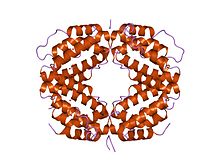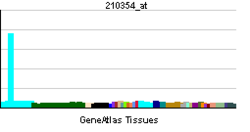γ-干扰素
(重定向自干扰素伽玛)
干扰素-γ(Interferon gamma、Interferon-γ、IFNG、IFNγ)是水溶性二聚体的细胞因子[2]。是II型干扰素的唯一成员[3]曾被称为巨噬细胞活化因子。
| IFN-γ | |||||||||
|---|---|---|---|---|---|---|---|---|---|
 Crystal structure of a biologically active single chain mutant of human interferon gamma | |||||||||
| 鑑定 | |||||||||
| 標誌 | ? | ||||||||
| Pfam | PF00714(旧版) | ||||||||
| Pfam宗系 | CL0053(旧版) | ||||||||
| InterPro | IPR002069 | ||||||||
| SCOP | 1rfb / SUPFAM | ||||||||
| |||||||||
| 臨床資料 | |
|---|---|
| 商品名 | Actimmune |
| AHFS/Drugs.com | Monograph |
| MedlinePlus | a601152 |
| ATC碼 | |
| 识别信息 | |
| |
| CAS号 | 82115-62-6 98059-61-1 |
| DrugBank | |
| ChemSpider | |
| ChEMBL | |
| 化学信息 | |
| 化学式 | C761H1206N214O225S6 |
| 摩尔质量 | 17145.6 g/mol |
结构
编辑生物活性
编辑所有的细胞都可以产生干扰素-α和干扰素-β, 而干扰素-γ只由自然杀伤细胞(NK细胞)和活化的T细胞产生。I型干扰素对酸稳定,而干扰素-γ则遇酸变性。
干扰素-γ具有抗病毒、免疫调节及抗肿瘤特性[5]。干扰素-γ可以与干扰素伽玛受体(IFNGR)结合,进而调节JAK-STAT通路。干扰素-γ激活抗原提呈细胞,通过上调转录因子T-bet而促进I型辅助T细胞(Th1细胞)的分化。
干扰素-γ是I型辅助T细胞(Th1细胞)的标志性的细胞因子。II型辅助T细胞(Th2细胞)释放白细胞介素-4(IL-4)和白细胞介素-13(IL-13)。自然杀伤细胞和CD8+T细胞也产生干扰素-γ。干扰素-γ通过迅速降解RANK-RANKL信号通路的TRAF6而抑制破骨细胞形成。
治疗用途
编辑干扰素可以用来治疗传染病,但也能促成自體免疫。在接受干扰素伽玛治疗的病人中,多达19%的病人会有自體免疫.
干擾素IFNγ用於豬生殖與呼吸道綜合症PRRSV的治療上,有試驗發現干擾素IFNγ能活化先天免疫細胞,進而達到抑制病毒數量的效果。[6]
A型流感的治療上,也有小鼠試驗表現出當缺失干擾素後,流感感染小鼠死亡率大幅提升且體內病毒數量維持高濃度水平;相較之下,體內有干擾素存在的小鼠,流感病毒數量隨著干擾素的生成而逐漸下降。[7]
参考文献
编辑- ^ PDB 1FG9; Thiel DJ, le Du MH, Walter RL, D'Arcy A, Chène C, Fountoulakis M, Garotta G, Winkler FK, Ealick SE. Observation of an unexpected third receptor molecule in the crystal structure of human interferon-gamma receptor complex. Structure. September 2000, 8 (9): 927–36. PMID 10986460. doi:10.1016/S0969-2126(00)00184-2.
- ^ Gray PW, Goeddel DV. Structure of the human immune interferon gene. Nature. 1982 Aug 26;298(5877):859-63.
- ^ Gray PW, Goeddel DV. Structure of the human immune interferon gene. Nature. August 1982, 298 (5877): 859–63. PMID 6180322. doi:10.1038/298859a0.
- ^ Ealick SE, et al., Three-dimensional structure of recombinant human interferon-gamma. Science. 1991 May 3;252(5006):698-702.
- ^ Schroder K, Hertzog PJ, Ravasi T, Hume DA. Interferon-gamma: an overview of signals, mechanisms and functions. J Leukoc Biol. 2004 Feb;75(2):163-89.
- ^ Bautista, E. M.; Molitor, T. W. IFNγ inhibits porcine reproductive and respiratory syndrome virus replication in macrophages. Archives of Virology. 1999-06, 144 (6): 1191–1200. ISSN 0304-8608. doi:10.1007/s007050050578.
- ^ Hoshino, Akinori; Takenaka, Hiroshi; Mizukoshi, Osamu; Imanishi, Jiro; Kishida, Tsunataro; Tovey, Michael G. Effect of anti-interferon serum of influenza virus infection in mice. Antiviral Research. 1983-03, 3 (1): 59–65. ISSN 0166-3542. doi:10.1016/0166-3542(83)90015-3.
延伸閱讀
编辑- Hall, Stephen K. A commotion in the blood: life, death, and the immune system. New York: Henry Holt. 1997. ISBN 0-8050-5841-9.
- Ikeda H, Old LJ, Schreiber RD. The roles of IFN gamma in protection against tumor development and cancer immunoediting.. Cytokine Growth Factor Rev. 2002, 13 (2): 95–109. PMID 11900986. doi:10.1016/S1359-6101(01)00038-7.
- Chesler DA, Reiss CS. The role of IFN-gamma in immune responses to viral infections of the central nervous system.. Cytokine Growth Factor Rev. 2003, 13 (6): 441–54. PMID 12401479. doi:10.1016/S1359-6101(02)00044-8.
- Dessein A, Kouriba B, Eboumbou C, Dessein H, Argiro L, Marquet S, Elwali NE, Rodrigues V, Li Y, Doumbo O, Chevillard C. Interleukin-13 in the skin and interferon-gamma in the liver are key players in immune protection in human schistosomiasis.. Immunol. Rev. 2005, 201: 180–90. PMID 15361241. doi:10.1111/j.0105-2896.2004.00195.x.
- Joseph AM, Kumar M, Mitra D. Nef: "necessary and enforcing factor" in HIV infection.. Curr. HIV Res. 2005, 3 (1): 87–94. PMID 15638726. doi:10.2174/1570162052773013.
- Copeland KF. Modulation of HIV-1 transcription by cytokines and chemokines.. Mini reviews in medicinal chemistry. 2006, 5 (12): 1093–101. PMID 16375755. doi:10.2174/138955705774933383.
- Chiba H, Kojima T, Osanai M, Sawada N. The significance of interferon-gamma-triggered internalization of tight-junction proteins in inflammatory bowel disease.. Sci. STKE. 2006, 2006 (316): pe1. PMID 16391178. doi:10.1126/stke.3162006pe1.
- Tellides G, Pober JS. Interferon-gamma axis in graft arteriosclerosis.. Circ. Res. 2007, 100 (5): 622–32. PMID 17363708. doi:10.1161/01.RES.0000258861.72279.29.

